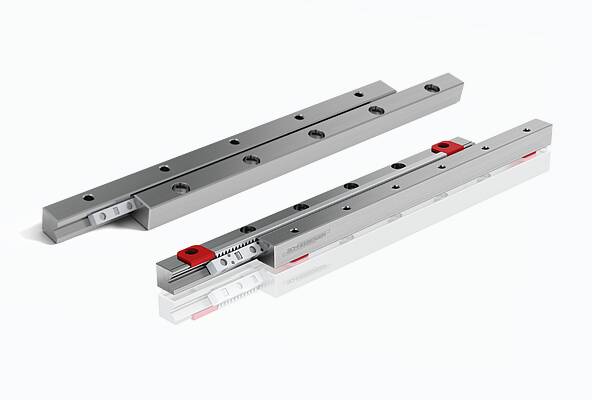
SCHNEEBERGER cross-roller guideways of types R, RN and RNG – we guarantee the right solution
Our type R cross-roller guideways as well as our type RN and RNG guideways are available in three quality classes (NQ, SQ and SSQ) for use under operating temperatures of -40° to +80°C. It is also possible to equip RN and RNG guideways with the FORMULA-S cage control to prevent cage creep. Similarly, it is possible to combine R and RD guideways with Type SK, SKD, SKC and SRrecirculating units.
Type RN
The type RNlinear guideway is an enhanced version of the type R guideway. It offers the same dimensions, but due to the larger contact surfaces of the guideway tracks it offers a higher performance level. The reduced gap width between the guide rails also provides better protection against contamination.
Type RNG
Like the type RN, the linear guideway type RNG has larger contact surfaces for the guideway track. Compared to the R and RN guideways their cross-section is smaller, requiring minimal space and weight-optimization, which offers a decisive advantage in highly dynamic applications
Cross roller guideways are precise linear guide systems consisting of highly accurate ground rails and cages. These cages are equipped with balls, rollers, or needles, which move between the raceways of the rails. They enable precise linear movements and provide high load capacity with minimal friction.
Cross roller guideways are characterized by their high stiffness, load capacity, and precision. They minimize deformation under load and offer excellent performance in applications requiring high precision and load capacity, such as in robotics, metrology, and machine tools.
SCHNEEBERGER offers several types of cross roller guideways:
Type R: These versatile guideways can be used in many industries and are available with both ball and roller cages.
Type RN: This variant offers higher load capacity and stiffness. It is ideal for precision applications and can optionally be equipped with cage control.
Type RNG: These guideways have a smaller cross-section and are designed for applications where space and weight are critical factors.
The installation of cross roller guideways requires precise alignment of the components. For optimal performance, regular lubrication should be carried out, and the guideways should be checked for wear. SCHNEEBERGER provides detailed instructions and training for installation and maintenance.
Cross roller guideways are used in a wide range of industries, including the automotive industry, aerospace, medical technology, machine tool construction, and semiconductor manufacturing. They are used wherever high precision and load capacity are required.
Cross roller guideways are precise linear guide systems consisting of highly accurate ground rails and cages. These cages are equipped with balls, rollers, or needles, which move between the raceways of the rails. They enable precise linear movements and provide high load capacity with minimal friction.
Cross roller guideways are characterized by their high stiffness, load capacity, and precision. They minimize deformation under load and offer excellent performance in applications requiring high precision and load capacity, such as in robotics, metrology, and machine tools.
SCHNEEBERGER offers several types of cross roller guideways:
Type R: These versatile guideways can be used in many industries and are available with both ball and roller cages.
Type RN: This variant offers higher load capacity and stiffness. It is ideal for precision applications and can optionally be equipped with cage control.
Type RNG: These guideways have a smaller cross-section and are designed for applications where space and weight are critical factors.
The installation of cross roller guideways requires precise alignment of the components. For optimal performance, regular lubrication should be carried out, and the guideways should be checked for wear. SCHNEEBERGER provides detailed instructions and training for installation and maintenance.
Cross roller guideways are used in a wide range of industries, including the automotive industry, aerospace, medical technology, machine tool construction, and semiconductor manufacturing. They are used wherever high precision and load capacity are required.
